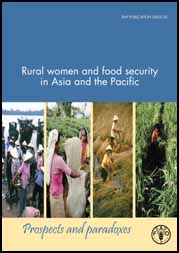|
The designation and presentation of material in this
publication do not imply the expression of any opinion whatsoever on the part of
the Food and Agriculture Organization of the United Nations concerning the legal
status of any country, territory, city or area of its authorities, or concerning
the delimitation of its frontiers and boundaries.
All rights reserved. Reproduction and dissemination of material in this
information product for educational or other non-commercial purposes are
authorized without any prior written permission from the copyright holders
provided the source is fully acknowledged. Reproduction of material in
this information product for sale or other commercial purposes is prohibited
without written permission of the copyright holders. Applications for
such permission should be addressed to Revathi Balakrishnan, Senior Officer,
Gender and Development, FAO Regional Office for Asia and the Pacific,
Maliwan Mansion, 39 Phra Atit Road, Bangkok 10200, Thailand or by e-mail
to [email protected].
|
